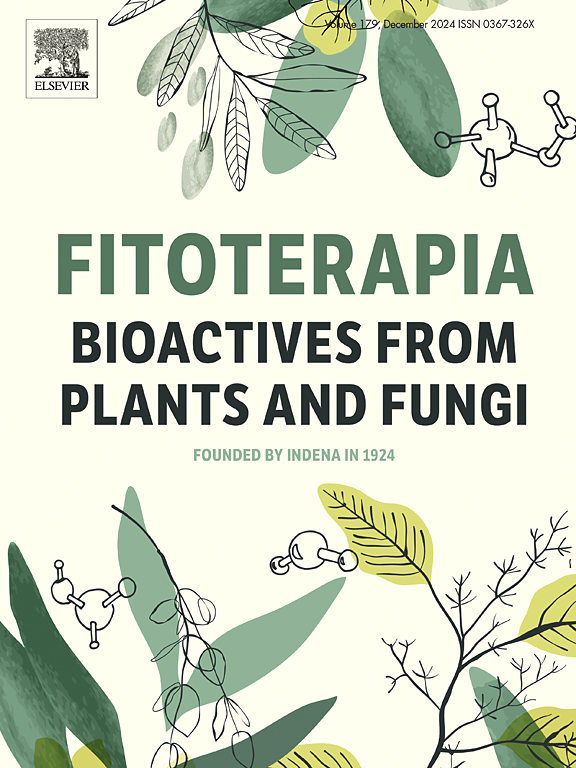Phytochemical profile of bioactive Siraitia grosvenorii root fraction and its potential against nonsmall cell lung cancer in vitro and in vivo
IF 2.5
3区 医学
Q3 CHEMISTRY, MEDICINAL
引用次数: 0
Abstract
Siraitia grosvenorii (Swingle) C. Jeffrey (SG) is an edible medicinal plant traditionally used to alleviate pulmonary and intestinal diseases in China. Rising demand for SG has led to significant generation of discarded SG roots (SGRs), while previous studies have shown that SGR extract possesses antiproliferative activity against cancer cells. However, its therapeutic potential for nonsmall cell lung cancer (NSCLC) and underlying molecular mechanisms remain uncharacterized. In this study, liquid chromatography ion trap time-of-flight mass spectrometry analysis identified 26 constituents from the active fraction of SGR (SGR2), predominantly categorized as cucurbitane or nor-cucurbitane triterpenoids and their glycosides. SGR2 inhibited the proliferation of A549 cells by inducing apoptosis and cell cycle arrest. In a xenograft tumor model, low-dose SGR2 treatment significantly suppressed tumor growth while exhibiting no observable adverse effects. RNA-seq analysis revealed that SGR2 impacted multiple targets and key pathways relevant to cancer therapy, notably including the JAK/STAT pathway. Western blotting analysis confirmed that SGR2 inhibited the JAK2/STAT3 pathway by reducing phosphorylation expression of JAK2 and STAT3 in both in vitro and in vivo models, and molecular docking studies demonstrated strong binding affinities between active compounds and key target proteins. These findings underscore the remarkable efficacy of SG byproducts and demonstrate their potential applications in NSCLC treatment. The results also contribute to the enhanced productivity and sustainability of SG cultivation.

生物活性罗汉果根部位的植物化学特征及其体外和体内抗非小细胞肺癌的潜力。
罗汉果(Siraitia grosvenorii) (Swingle) C. Jeffrey (SG)是一种可食用的药用植物,在中国传统上用于缓解肺部和肠道疾病。对SG需求的增加导致大量丢弃SG根(SGR)的产生,而先前的研究表明SGR提取物具有抗癌细胞增殖活性。然而,其治疗非小细胞肺癌(NSCLC)的潜力和潜在的分子机制仍不清楚。在本研究中,离子阱飞行时间液相色谱-质谱分析从SGR (SGR2)的活性部位鉴定出26种成分,主要分类为葫芦烷或去葫芦烷三萜及其苷类。SGR2通过诱导细胞凋亡和细胞周期阻滞抑制A549细胞的增殖。在异种移植肿瘤模型中,低剂量SGR2治疗可显著抑制肿瘤生长,但无明显不良反应。RNA-seq分析显示,SGR2影响与癌症治疗相关的多个靶点和关键通路,特别是JAK/STAT通路。在体外和体内模型中,Western blotting分析证实SGR2通过降低JAK2和STAT3的磷酸化表达来抑制JAK2/STAT3通路,分子对接研究表明活性化合物与关键靶蛋白之间具有很强的结合亲和力。这些发现强调了SG副产物的显著疗效,并展示了它们在非小细胞肺癌治疗中的潜在应用。结果还有助于提高SG种植的生产力和可持续性。
本文章由计算机程序翻译,如有差异,请以英文原文为准。
求助全文
约1分钟内获得全文
求助全文
来源期刊

Fitoterapia
医学-药学
CiteScore
5.80
自引率
2.90%
发文量
198
审稿时长
1.5 months
期刊介绍:
Fitoterapia is a Journal dedicated to medicinal plants and to bioactive natural products of plant origin. It publishes original contributions in seven major areas:
1. Characterization of active ingredients of medicinal plants
2. Development of standardization method for bioactive plant extracts and natural products
3. Identification of bioactivity in plant extracts
4. Identification of targets and mechanism of activity of plant extracts
5. Production and genomic characterization of medicinal plants biomass
6. Chemistry and biochemistry of bioactive natural products of plant origin
7. Critical reviews of the historical, clinical and legal status of medicinal plants, and accounts on topical issues.
 求助内容:
求助内容: 应助结果提醒方式:
应助结果提醒方式:


